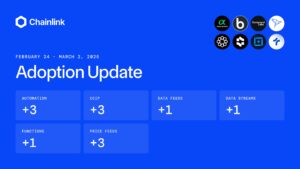What is Chainlink? Why is it Called the “Bridge Between Blockchain and the Real World”?
Chainlink (LINK) is a decentralized oracle network founded by Sergey Nazarov and Steve Ellis in 2017. Its core mission is to solve the “data silo” problem of blockchains—since blockchains cannot directly access external data, smart contracts must rely on oracles to fetch real-world information (such as stock prices, weather data, and sports results).
For example, when you use a DeFi platform to borrow against your crypto collateral, the platform needs real-time ETH price data to determine if liquidation should be triggered. Chainlink’s oracle nodes aggregate price data from multiple exchanges, encrypt and verify it, and then transmit it to the smart contract. This process ensures data accuracy and prevents manipulation by eliminating reliance on a single data source. According to JuCoin data, over 90% of top DeFi protocols rely on Chainlink for price feeds.

LINK Token: More Than Just a Payment Tool
LINK is the native token of the Chainlink network, with a total supply of 1 billion tokens. Its role goes beyond just paying for node services:
- Node Collateral: Operators must stake LINK as a “security deposit”; providing incorrect data may result in slashing.
- Governance & Reputation: A node’s performance (speed and accuracy) affects its chances of being selected. Holding more LINK increases competitiveness.
- Technical Features: Built on the ERC-677 standard, LINK allows transactions to trigger smart contract logic, enhancing efficiency.
As of March 2025, LINK remains among the top 20 cryptocurrencies by trading volume, with price fluctuations closely tied to overall DeFi market demand.
Chainlink’s Technological Moat and Industry Position
Chainlink’s success stems from its unique security architecture: over 1,000 global node operators (including Swisscom and Google Cloud) participate in data validation, ensuring trustworthiness through multi-layered data aggregation and cryptographic signatures. As of March 2025, Chainlink has served over 2,000 blockchain projects, holding more than 80% market share.
Recent technological breakthroughs include:
- Smart Value Recovery (SVR): Optimizes DeFi liquidation processes to improve capital efficiency.
- Cross-Chain Interoperability Protocol (CCIP): Enables data interoperability between Ethereum, Solana, and other chains, facilitating use cases like NFT floor price tracking.
These innovations reinforce Chainlink’s role as a fundamental “blockchain data infrastructure.” However, challenges remain—cross-chain latency issues have yet to be fully resolved, and the SEC may classify LINK as an unregistered security (similar to the XRP lawsuit).
How Should Investors Evaluate Chainlink’s Value?
Chainlink’s value is deeply tied to the adoption of DeFi and blockchain applications. If the Web3 ecosystem continues to expand, the demand for reliable data will drive LINK’s long-term growth. Key indicators to watch include:
- DeFi Total Value Locked (TVL): Measures demand strength by tracking top protocol deposits.
- Node Growth: The number of operators and data requests indicates network activity.
- Regulatory Developments: SEC rulings on cryptocurrencies may impact liquidity.
Analysts remain divided in their forecasts: Optimists predict LINK could surpass $80 if DeFi demand surges, while conservatives warn of a potential decline to $15 due to technical challenges or regulatory risks. Rational investors should balance risk and reward by analyzing on-chain metrics and market sentiment.
Chainlink’s evolution is not only a testament to technical innovation but also a crucial step toward integrating blockchain with the real world. Its success or failure will profoundly impact the next decade of decentralized applications.




